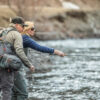“Respect your quarry.” ~ Paul Guernsey
Learning how to properly land and release fish is as important as learning how to read the water, cast, and set the hook. Studies have shown that when large trout are fought to exhaustion, then held out of the water for 30 to 60 seconds during hook removal and photo, these trout have a dramatic decrease in their survival rate. Here is a useful analogy…imagine you have just competed a 100 yard dash, and just when you need oxygen the most, your head is dunked under water for a minute…very uncomfortable. Here is a list of ways to show respect to your quarry: (1) Always land your fish as quickly as possible. (2) Handle the fish as little as possible. Learn how to use a Ketchum Release. (3) Take lots of pictures of the entire process of landing and releasing the fish, and if the camera is not ready, keep the fish in the water until it is and only remove the fish for a few seconds for the photo. (4) When holding a fish, always have wet hands and support the weight of the fish without squeezing it. (5) Revive the fish with its head into the current until it is ready to swim away.
SILVER CREEK
We are looking forward to another great week of Trico action in the morning at the Creek. The cooler weather last week slowed down the hatch a bit, but with the weather stabilizing this week, the Tricos should get back on track. Along with the Tricos, you will also see Baetis, Callibaetis, and PMDs throughout the morning. Traditionally, this week and the next are the peak of the Trico hatch, and then we should see it slowly dwindle as we head into the latter part of August. If you go, be sure you have the right leader, tippet and flies to fish this hatch. I recommend a 12 foot leader to 6X along with Trico and Baetis spinners in size 22 and 24. The fish can be very selective at this stage of the hatch and a perfect drift matched with a the right fly are a must to be successful. During the middle of the day, the Damsels and Callibaetis are the main fare. Hoppers, beetles and ants are also working if there is a slight wind chop on the surface. In the evenings there is a smorgasbord of bugs right at sun down. For twilight fishing, always have a few flies that are easy to see in the fading light.
THE BIG WOOD
The Wood is fishing inconsistently, though recent reports do show signs of improvement. The recent cold weather triggered some terrific fishing spurred by strong hatches of Baetis, Tricos, and PMDs. Caddis have also been very good in the evening. While there seem to be fewer large fish in the river, and a plethora of small fish, some really big fish have been caught lately in the Wood. Fishing small parachute patterns or dry dropper rigs in the shallow riffles or seams along the sides of the heavy water is best. For flies try small (12-16) yellow Stimulators, Parachute Hare’s Ear, Adams, or Purple Haze trailed by a Rainbow Warrior, Zebra Midge, or Bishop’s Dynamite in size 16 or 18.
SOUTH FORK OF THE BOISE
The flows have actually gone up to 1,840 CFS. This is still best fished from a drift boat; however, getting out and working the riffles and runs may be more effective as the bank feeders have been pounded. The main bugs are still PMDs and Pink Alberts and the hatch is occurring late morning into the afternoon. Caddis are around mostly in the evening. The most productive method remains nymphing with Stone fly nymphs, Caddis Larva, and Midge patterns with an indicator, dry dropper, or fished Euro Style.
LOCAL PONDS
Lake Creek, Penny Lake, or Gaver’s Lagoon are all great places to practice casting and catching. All the ponds have been stocked and will receive regular stockings throughout the summer season. Drop on by before you go or take your family fishing and we will make sure you have the right gear to be successful.
SALMON RIVER
The flows are quite low, making the upper river very easy to walk and wade and we are still floating the lower river. Spruce moths are the starting to make an appearance and a size 16 or 14 cream colored Elk Hair Caddis works well to imitate this bug. Focus on the areas that are heavily wooded with evergreens and you will find the moth. Small hoppers and stimulators are also very effective. Fishing dry dropper style with size 14-16 bead head nymphs is also productive. Valley, Marsh, and Bear Valley Creeks are all fishing well.

BIG LOST BELOW MACKAY
The flows have dropped again to 250 CFS. This tailwater jewel is just coming into its prime. You should experience decent Tricos in the morning with Baetis, PMDs, Yellow Sallies, and Midge hatching throughout the day. If you move about, you should be able to find decent numbers of surface feeding fish. They can be selective, so take along your Silver Creek Tricos and Baetis; however, small standard Parachute patterns may be all you need. While nymphing, try Rubber Leg Stones, San Juan Worms, and King Princes in the heavy runs. For the shallow water, try small nymphs like Zebra Midge, Bishop’s Dynamite, and Rainbow Warriors in size 16 and 18.
UPPER LOST- COPPER BASIN
The fishing in this area is spotty at best. Anglers that move around will find fish, and sometimes nice fish, but the low numbers of fish per mile make it difficult for this area to fish consistently well. If you go, go with low expectations and enjoy the solitude and scenery. When you do find fish, they will be opportunistic feeders and a well presented hopper or other attractor pattern will turn fish. Nymphing is a good way to get into the only protected fish in the area, the Mountain Whitefish.
|
Big Wood Big Lost Silver Creek Copper Basin South Fork of the Boise |
186 cfs 255 cfs 105 cfs 48 cfs 1820 cfs |




